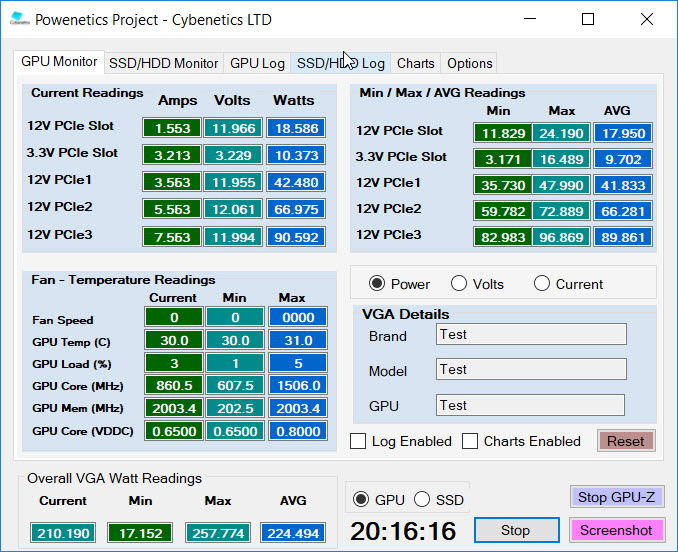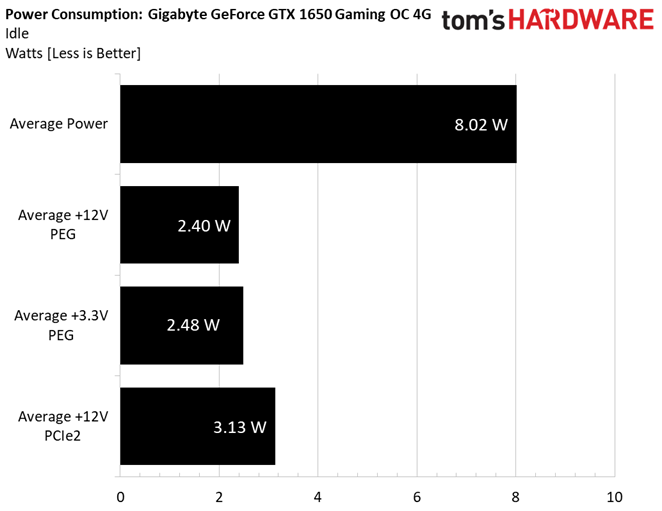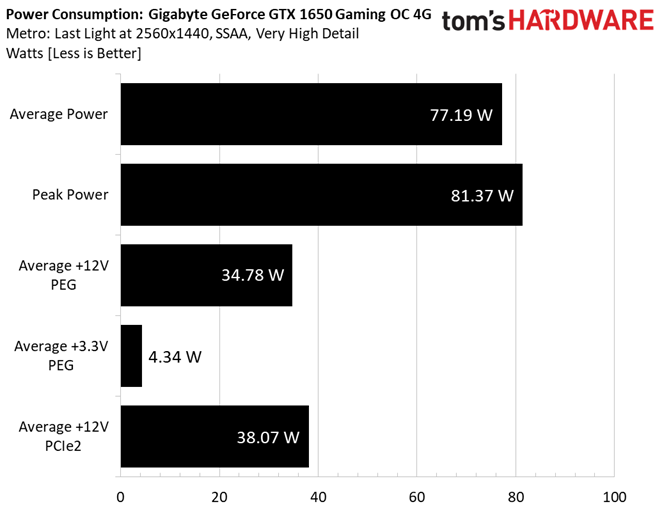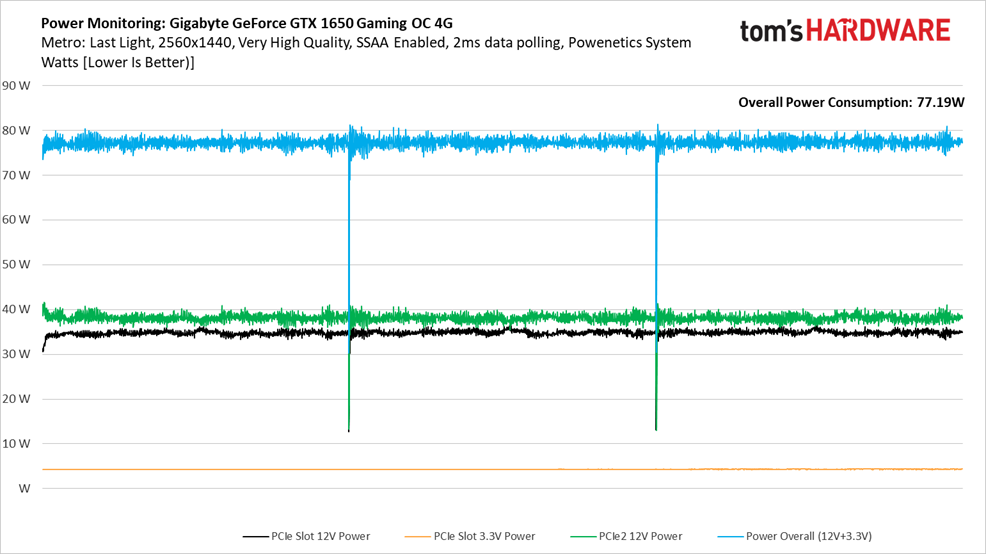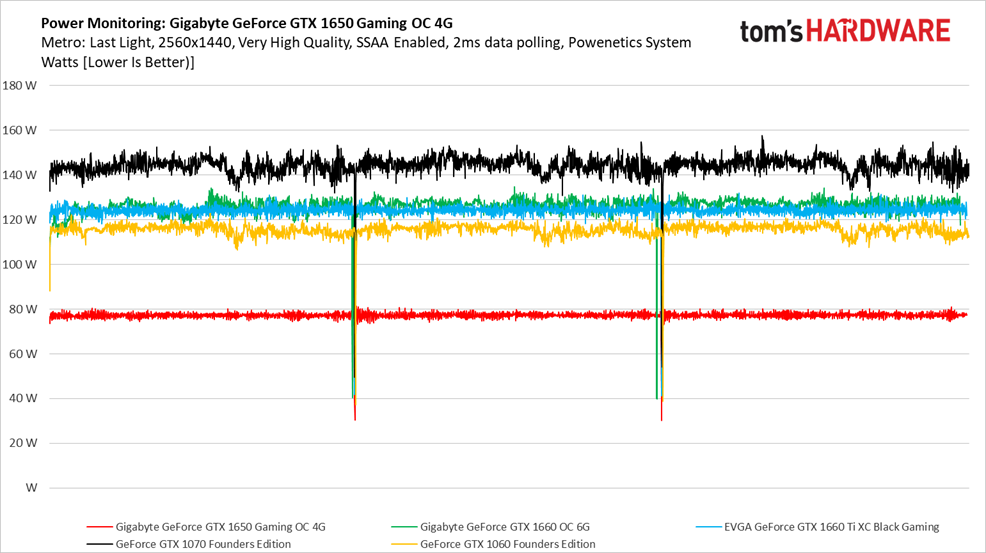Nvidia GeForce GTX 1650 4GB Review: This Turing Fails the Test
Why you can trust Tom's Hardware
Power Consumption
Slowly but surely, we’re spinning up multiple Tom’s Hardware labs with Cybenetics’ Powenetics hardware/software solution for accurately measuring power consumption.
Powenetics, In Depth
For a closer look at our U.S. lab’s power consumption measurement platform, check out Powenetics: A Better Way To Measure Power Draw for CPUs, GPUs & Storage.
In brief, Powenetics utilizes Tinkerforge Master Bricks, to which Voltage/Current bricklets are attached. The bricklets are installed between the load and power supply, and they monitor consumption through each of the modified PSU’s auxiliary power connectors and through the PCIe slot by way of a PCIe riser. Custom software logs the readings, allowing us to dial in a sampling rate, pull that data into Excel, and very accurately chart everything from average power across a benchmark run to instantaneous spikes.
The software is set up to log the power consumption of graphics cards, storage devices, and CPUs. However, we’re only using the bricklets relevant to graphics card testing. Gigabyte's GeForce GTX 1650 Gaming OC 4G gets all of its power from the PCIe slot and one six-pin PCIe connector.
Idle
Idle power consumption just over 8W is impressive. Thanks for that goes to a combination of Nvidia's TU117 processor and Gigabyte's semi-passive fan mode.
Gaming: Metro: Last Light
A 77.1W average measurement is slightly higher than Nvidia’s specification for GeForce GTX 1650. The peak to just over 81W isn’t egregious, at least.
Get Tom's Hardware's best news and in-depth reviews, straight to your inbox.
Gigabyte balances power consumption between the PCI Express x16 slot and six-pin power connector, explaining why trying to run this card without the connector attached does not work. There's even a bit of 3.3V rail utilization.
Charting power consumption across our three-run benchmark shows the narrow range we’re working with. This card is remarkably consistent, demonstrating even utilization across the test sequence and giving us no reason to believe TU117 is limited by thermals or power.
That red line is the GeForce GTX 1650 Gaming OC 4G. Although we're critical of its performance and value, there's no denying that this is an efficient graphics card well-suited to environments sensitive to power consumption.
Less than 4A of current draw on the PCIe slot is well within the PCI-SIG's limits. Again, Gigabyte takes care to balance power between the PCIe slot and auxiliary six-pin connector.
FurMark
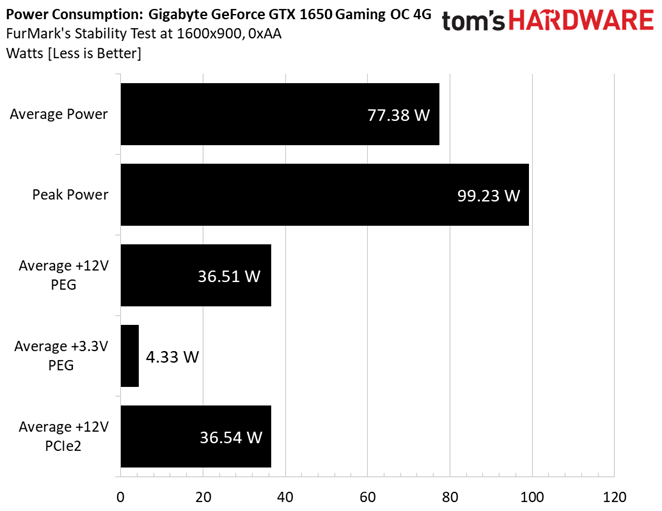
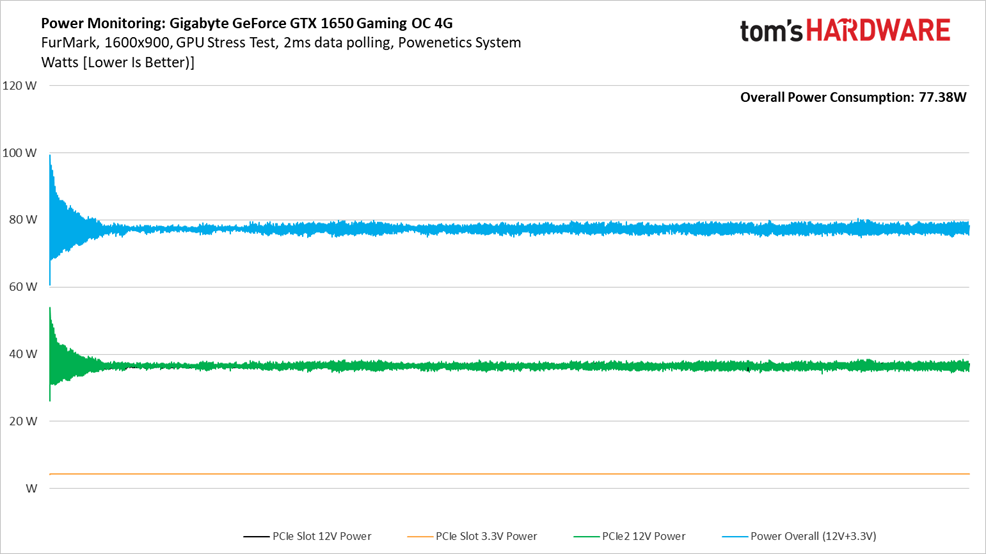

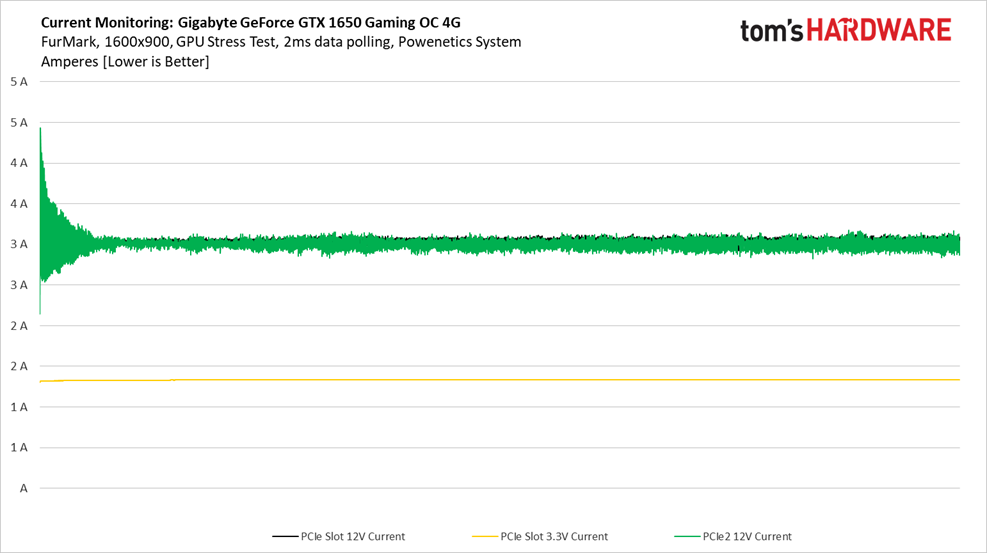
MORE: Best Graphics Cards
MORE: Desktop GPU Performance Hierarchy Table
MORE: All Graphics Content
Current page: Power Consumption
Prev Page Gaming at 1920 x 1080 Next Page Temperatures, Fan Speeds, and Clock Rates-
Thanks for the Review....I think the RX 570 is still going strong and ahead of the GTX 1650..This TURING entry-level GPU seems to have poor price/performance ratio though.Reply
EDIT, Btw, you are correct about the all the points which you have mentioned under CON, including the last one as well. GTX 1650 lacks Turing NVENC Encoder, packs Volta's Multimedia Engine.
https://www.techpowerup.com/254861/nvidia-gtx-1650-lacks-turing-nvenc-encoder-packs-voltas-multimedia-engine -
renz496 nvidia most likely did not intend this card to be price/performance king. they most likely banking on it's power efficiency to gain momentum in similar way to GTX750ti and GTX1050ti before. right now this is the fastest sub 75w GPU. nvidia probably can be more aggressive on the pricing but this generation their attention is mostly on the mid range. hence we saw much aggressive pricing with GTX1660ti and GTX1660.Reply -
TMTOWTSAC I think the GPU itself makes sense, but this partner board doesn't. For users who would otherwise have to purchase a new PSU you can charge a price premium. Take that away and actually charge more for it, while offering less performance per dollar? I've never understood the partner board mentality of tricking out a lower tier model until it costs more than a higher tier while still falling short of its performance.Reply -
cryoburner Reply
I wouldn't expect all that much more from it. The 1650 is already pushing the limits of what this graphics chip can do within a 75 watt power envelope, and even this $180 factory overclocked model that requires an external power connector performs around 10% below an RX 570 on average. The 1650 Ti will probably manage to outperform the RX 570 and 1060 3GB, but that card is expected to start around $180 for the base models.Diabl0 said:Waiting for 1650Ti
And that's the biggest problem with these cards. They are terribly priced. 2 1/2 years ago, the 1050 launched with a $109 MSRP and the 1050 Ti launched with a $139 MSRP. The 1650 is already launching for a higher base price than the 1050 Ti launched for, and the 1650 Ti will be launching for a price not far below what the 1060 3GB and RX 480 4GB were back in 2016, for performance that will likely not be much better. If you wanted that level of performance for that price, you could have had it years ago. And at this point, you can get that level of performance for around $130 with an RX 570. If these cards were priced closer to what the previous generation hardware launched for, perhaps starting around $120 for the 1650, and $150 for the 1650 Ti, they would have been decent options. They're priced at least 20% higher than they should be though.
About the only real advantage these cards hold is that they have low power draw, allowing them to run on low-end 300-350 watt power supplies found in some pre-built systems, at least assuming you get a card that doesn't require a PCIe power cable, but those will likely perform slightly behind what's shown here. -
Loadedaxe I had high hopes for this card. I almost bought a RX 580 4GB on sale for $149. last month. Now I found a RX580 4gb on sale for $169.Reply
Sorry nVidia. You will have to do better in this price range. Maybe if it cost $129...but not $179 -
salata I am looking for the GPU for my OEM Dell. This card does not perform to justify the price now. For me is better to consider replacement including moding my MT case in order to fit ATX psu and RX580 or 1660. This card should 30-40 bucks cheaper for me to consider buying it. I'm as well fine waiting for NAVI 12 based 75W GPU.Reply -
How did this review thread/Topic land here, under Graphics cards sub-forum ? Shouldn't it supposed to be here:Reply
https://forums.tomshardware.com/forums/reviews-comments.67/ -
escksu This card isn't really a fail.... It may be sucky as a normal desktop card but its the fastest low profile GPU out there and it doesn't require additional power. Anyone who has a small casing and need additional juice, this is the best card for them!!Reply -
cryoburner Reply
Except it's not a low-profile card. Looking on PCPartPicker, every 1650 that's available right now is a full-width card. There is apparently one low-profile Zotac 1650, but it's not stocked by any US retailers tracked by PCPartPicker at this time...escksu said:This card isn't really a fail.... It may be sucky as a normal desktop card but its the fastest low profile GPU out there and it doesn't require additional power. Anyone who has a small casing and need additional juice, this is the best card for them!!
https://pcpartpicker.com/products/video-card/#c=443&sort=price&page=1
Further, a majority of them DO require external power, including the one tested for this review, and the ones that don't tend to perform a little slower.
That's not to say the card is useless though, and for someone looking for a budget card for a pre-built system with something like a 350 watt PSU, it could make sense (provided they are not trying to fit it in a slim case).
